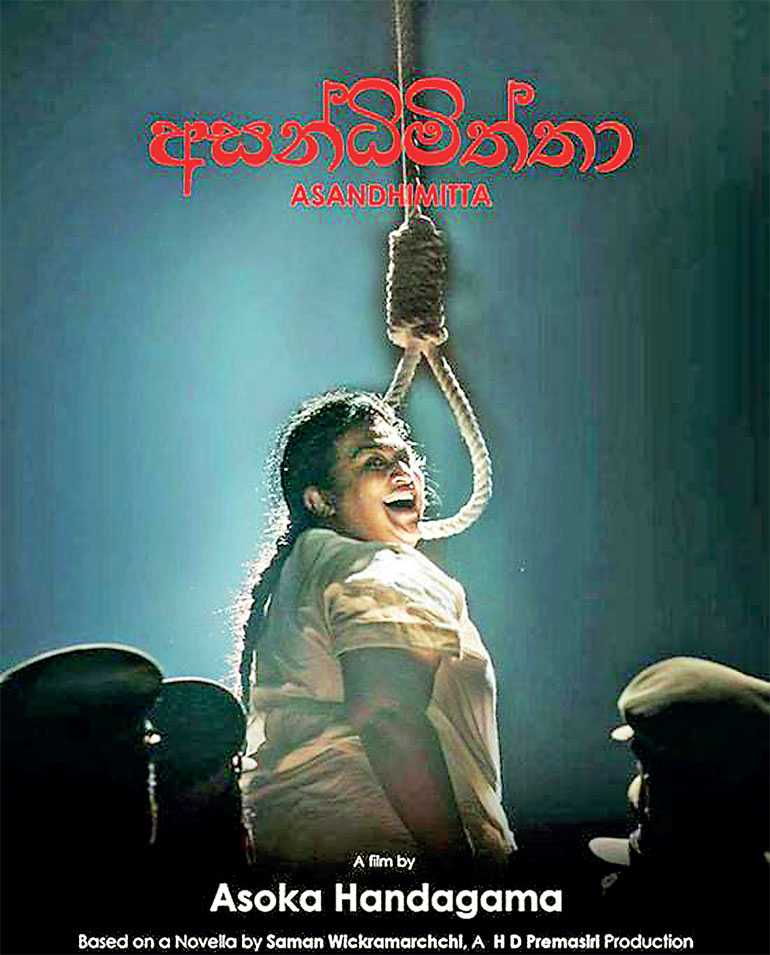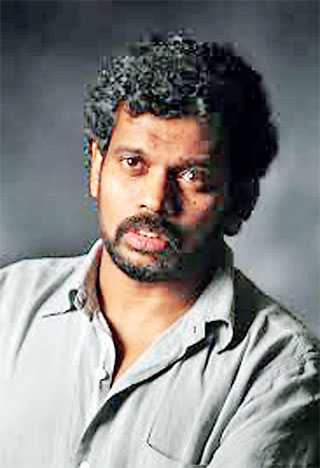Saturday Apr 12, 2025
Saturday Apr 12, 2025
Monday, 25 March 2019 00:30 - - {{hitsCtrl.values.hits}}
Handagama: The women’s man
Sri Lanka’s award winning film director, Asoka Handagama, screened his latest creative work, Asandimitta, before an invited audience in Colombo last week. This was a prelude to its public release, which was to be commenced immediately. 
Handagama is normally considered a ‘women’s man’ because the themes of all his past movies had centred on women who had been victimised by society in one way another. His ‘Channa Kinnarie’ focused on the plight of the single mother working woman. ‘Moon Hunt’ was about a woman who had fallen victim to unfulfilled sexual desires of young soldiers holed up in bunkers when death was the only possibility waiting for them. His ‘Flying with One Wing’ brought to the focus the crude reality faced by women with a different sexuality. ‘The Letter of Fire’, not screened for public viewing, looked at the sad state faced by a professional legal woman when she had to choose between law and her juvenile son, a fugitive from the law. While his ‘Ini Avan’ was on a woman caught up in Sri Lanka’s long ethnic war, ‘Let Her Cry’ dramatised the conflict between two women loving the same man.
Now his latest, Asandimitta, based on a novella by Saman Wickramaarachchi, has been on a completely different theme. It is about a woman born with a genetic code that had given her an extraordinarily large physique. Society normally views such physique as somewhat weird, because it does not conform to the accepted norms of beauty. For such women (and for men as well), it is the source of a mental trauma tormenting them all through their life. If anyone makes an adverse comment on their body or any part of the body, that would be enough to drive them to a deep mental depression that would linger on them for days. Though Handagama had chosen to brand Asandimitta as a movie with a psychoanalytic theme, it is much more than that. It is a fine blend of other analytics, falling into social, cultural, economic and political arenas as well.
 |
Asoka Handagama Asandimitta |
 |
Asoka Handagama |
Split personalities
The lead character Asandimitta (Nilmini Sigera) is introduced to viewers through her voice when she has a telephone conversation with a filmmaker (Shyam Fernando) who had been one of her school mates. The filmmaker cannot help making the derogatory remark that she had a fat figure during school days. Asandimitta, not offended by his remark, admits that she is still fat, weighing 300 pounds. This is possibly because she had a carefully crafted scheme to take her final revenge on her tormentors. She then confesses that she had killed or helped kill three women and wanted him to use her story in a film.
From there onward, the story is unravelled to viewers from what she tells him. Handagama has portrayed her as a woman suffering mentally, because wherever she goes, other eyes notice nothing but her fat figure; some of them even make lewd remarks about her protruding backside, while some others impulsively touch or pinch her backside. Though she takes those liberties only with a frown, internally, she is a boiling pot that could explode at any time. This continued mental trauma has caused her to suffer from a psychotic condition known as ‘split personality’.
The godly and satanic sides of Asandimitta
A person suffering from split personality imagines different characters and lives in them in an imaginary world. Asandimitta has not received love, respect or recognition throughout her life. It then becomes a morbid desire to have them fulfilled. To do so, she assumes two characters, one called Young Wicky (Dharmapriya Dias) portraying the loving or godly side, and the other, called Old Wicky (W Jayasiri), representing the brutal or satanic side. Young Wicky is a man she sees at the bus station and imagines that he follows her to her house.
Young Wicky is transformed in her mind to Old Wicky whenever she needs to display brutality. She swings from one character to the other, while living her normal life in between. The Young Wicky is of an accommodating type and believes that there is nothing wrong with a man looking after the household, while the woman is at work outside. In fact, it is Asandimitta herself who believes so, to satiate her desire to dominate males. When she makes several demands from him, Young Wicky, who temporarily occupies her, accedes to all of them. When she suggests that they should visit Anuradhapura, he agrees; to Kandy and to Peradeniya Botanical Garden, he still agrees. When she changes the subject and suggests that the roof should be repaired, he agrees to that too. She then tells him that she wants to flirt occasionally, and he agrees to that too. She says that she is fat and like a ball, but Young Wicky says that he loves fat women and likes to play with a ball. If people start laughing at their mismatch, he says he does not care and would laugh at them before they would do so.
From tenderness to rough handling
Hence, that side of her split personality pleases her in every respect. He is caring, supporting and depending on her. But the Old Wicky side of her split personality is brutish, maltreating and cruel. She desires that too. She starts love-making with loving Young Wicky, who does it with utmost tenderness and care. But the brutish side of her split personality demands something else. Hence, she does the actual love-making with Old Wicky, who has no consideration for tenderness. After it is over, showing her anger at his crude brutality, she scolds him and asks him to leave her house immediately. But his response is to pull out a dagger and threaten to drive its eight-inch long blade freely into her fleshy body. Since it is she who says so, it is an admission that she is concerned about the vulnerability of her fleshy body to a knife attack. She surrenders herself and patches up the differences with him. In this manner, moving from one personality to the other, she places herself in the best of all the best worlds.
Kali’s shrine
Handagama then brings in social, cultural, political, and economic analytics to the movie. Asandimitta loses her job as a parking attendant, because the rich car owners refuse to pay a parking fee for parking their vehicles on the street. She, without a means to live, laments whether society expects women of her background to sell their bodies. Young Wicky, who is also concerned because they have now lost their only income, suggests that they convert an unused hall in the house to a God’s Shrine. Culturally, people need stories to live by, and one such story is that gods take possession of women, giving them an extraordinary sight.
Asandimitta pretends that she has been possessed by Goddess Kali, and people flock to her God’s Shrine to have numerous mysteries solved. The modus operandi is that her two sons, who mix with the crowd, surreptitiously pick up the purposes of their visit, and alert her from behind the curtain. She then summons the exact person, pretending that it is Kali who had asked her to do so. A solution is given to him or her promptly, while collecting the offering they make to the Goddess. But this enterprise ends abruptly when one of her sons picks a purse of one of the visitors, and the agitated crowd, now knowing that it is a fake, destroys the shrine. Asandimitta is once again back to where she was.
Lonely Women’s Refuge
Another scheme to make money is hatched by the godly side of her split personality. This time, she uses the social, political and economic agitations of people, especially socially or culturally victimised women, to make money. They form a fake organisation called the Lonely Women’s Refuge, to rope in unsuspecting women in need. Once a victim is identified, she pursues correspondence with her, suggesting that she has an unmarried brother who can take care of her. One such woman uses someone else’s address to write to her.
When Asandimitta and Young Wicky visit the house to make the final killing, they find that it belongs to a rich family, where there are three women living alone. Mother (Anula Bulathsinghala) is disabled and in a wheel chair. Of the two daughters, the elder one (Gayani Gisanthika) lives with her mother because her husband has left her. The younger one (Sandali Handagama) is waiting for any outside contact to surface to overcome her boredom. Both offer a godly chance to Asandimitta and Young Wicky to pursue their crafty scheme, because they are ripe for being roped in. Deceived by a few flattering talks by Young Wicky, the two sisters invite the duo into the house. The real plot begins to unravel inside that house.
Killing three women
While having a casual chat over a cup of tea, Young Wicky makes advances toward the elder sister, who also responds positively. This is a part of the scheme they have in mind. The mother in the wheelchair, having smelled what is going to happen, scolds the two sisters for allowing them inside the house. But the two sisters, now sufficiently enchanted by the flattery, defy Mother and ask them to spend the night with them. Young Wicky plans to rope in the elder sister fully, so that Asandimitta and he could drain the family of its wealth. To activate the plan, a crucial requirement is to take the elder sister to bed.
But Asandimitta’s feminine instincts tell her to protect her man, who is nobody but she herself in a different form, from the sex-starved elder sister. First, she storms the room and warns Young Wicky. Then, not trusting him, she storms the room again, and gets him to promise her that he would not take her to bed. Still not trusting him, she imagines that Mother in the wheelchair, who could now walk, will frighten him away from what he is planning. Frightened to death, Young Wicky hides himself under the bed cover.
When the elder sister visits him in the middle of the night, Asandimitta changes Young Wicky to Old Wicky, who strangles the surprised elder sister to death. The plot now thickens in Asandimitta’s mind, caught up between fear dictated by her loving side and desire to revenge guided by her brutish side. This is one of the most dramatic events which Handagama has created in the movie. While Asandimitta is sitting on the staircase unable to move, Old Wicky, the brute, finishes the job by strangling the remaining two women one after the other.
Trusting unrealistic stories
The story and the characters are just an imagination in the mind of the main character, Asandimitta. But it is believed by the filmmaker, the police, and the courts. Handagama portrays here a weakness in human beings, who go by stories they have heard, and not by their instincts or rational thinking. If a story is repeated ad nauseam, it is believed to be true. When somebody comes up with a story compatible with the one already believed, they immediately accept it as true, though their rational thinking may tell them otherwise.
The filmmaker, who has been told the truth by the owner of the house where Asandimitta had lived, refuses to accept that it is a story created in her mind. He comes back to reality only when his wife (Yasodha Wimaladharma) plays a trick to force him to rush home to give him a surprise birthday party. But the police and the courts, who go by her story, decide to hang her for a crime which had never been committed. In that way, Asandimitta takes her final revenge of society which had maltreated her. She did not have courage to end her life. But she gets the insane society to put an end to her life by hanging her. Her loud laughter at the gallows is her cruel way of taking revenge.
From imagination to reality
The viewers, who also had taken Asandimitta’s imaginations as reality, are crudely woken up by the last scene in the movie. Young Wicky had in fact not followed Asandimitta in the bus which she had taken to go home. He has instead boarded another bus, and in reality, shared a seat in that bus with a young girl (Rithika Kodithuwakku), who has been reading the novella which Handagama has used for his movie. It brings the viewers back to reality from the imaginary world they had been living till then.
Superb performance by all actors
Nilmini Sigera, though it is her first appearance in the big screen, portrays a superb performance in the movie. Her facial expressions, conveying different mental states of the lead character, have been wonderful. Handagama has drawn the maximum from all the actors and actresses. A special mention should be made about Sandali Handagama, who appeared in the movie only briefly. Given her talent as an actress, it is now time for her to graduate from minor roles to a major role in a movie.
(W A Wijewardena, a former Deputy Governor of the Central Bank of Sri Lanka, can be reached at waw1949@gmail.com)
Discover Kapruka, the leading online shopping platform in Sri Lanka, where you can conveniently send Gifts and Flowers to your loved ones for any event including Valentine ’s Day. Explore a wide range of popular Shopping Categories on Kapruka, including Toys, Groceries, Electronics, Birthday Cakes, Fruits, Chocolates, Flower Bouquets, Clothing, Watches, Lingerie, Gift Sets and Jewellery. Also if you’re interested in selling with Kapruka, Partner Central by Kapruka is the best solution to start with. Moreover, through Kapruka Global Shop, you can also enjoy the convenience of purchasing products from renowned platforms like Amazon and eBay and have them delivered to Sri Lanka.
Discover Kapruka, the leading online shopping platform in Sri Lanka, where you can conveniently send Gifts and Flowers to your loved ones for any event including Valentine ’s Day. Explore a wide range of popular Shopping Categories on Kapruka, including Toys, Groceries, Electronics, Birthday Cakes, Fruits, Chocolates, Flower Bouquets, Clothing, Watches, Lingerie, Gift Sets and Jewellery. Also if you’re interested in selling with Kapruka, Partner Central by Kapruka is the best solution to start with. Moreover, through Kapruka Global Shop, you can also enjoy the convenience of purchasing products from renowned platforms like Amazon and eBay and have them delivered to Sri Lanka.